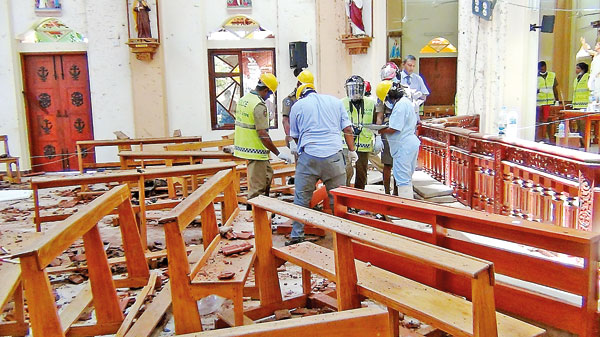Sunday Times 2
When ‘Flight or Fight’ – an essential human response becomes self destructive

In the aftermath of a devastating attack, to protect ourselves, we also seek like-minded people who reinforce our fears and stereotypes. Pic by Hiran Priyankara
As Sri Lanka struggles to come to terms with the senseless attacks on Sunday, April 21, it is important that we are aware of the pitfalls in our response to this tragedy. An unexpected massacre of innocent civilians, perhaps the most noble and religious amongst us, is something incomprehensible to the human mind.
It provokes fear and anxiety, the most basic and primitive response of all living beings programmed for self-preservation. The homeostasis of the mind is shattered as trust in fellow human beings built in to the neurons that facilitate the processes of the mind are sent in to disarray. The mind struggles to find coherence, an explanation and a framework in which to comprehend and reorganise itself.
Fear mode
In such situations, the mind goes in to a fear mode. The mind and the body activate the physiological ‘flight or fight’ response to safeguard itself and respond to the real or perceived threat. It is a protective response that has safeguarded all living beings from the beginning of time. However, as with most bodily responses, an excessive or prolonged activation of this response can eventually be self-destructive. The classic example in medicine is the inflammatory response following a physical injury.
When fear takes over, it does not rationalise or stop to think. Almost all logical processes shut down. An automatic default system takes over. What then are the components of this default network?
Stereotyping
In a heightened state of fear the brain focuses on any perceived threats which it has identified during the immediate process or from past experience. It clutches on to information that bring further threat whether visual, auditory or even cognitive. It ignores non threatful cues and seeks out the smallest threats to flee from or attack. Justifiably the brain manages risk by a quick overkill as opposed to rational thinking which is a slower process and may not be the best gamble in emergencies. We have to go with our instincts as they say.
The mind tries to identify anything and everything that resembles the threat. It tries to predict who or what is harmful. It relies on a process we call stereotyping. In this specific case, what did the attacker look like, what was he carrying, what is his background, what was he travelling in, what is his race or religion. These mental stereotypes ring alarm bells.
It is, nevertheless, a dangerous process. Innocent Muslims because of their faith, dress or background can become objects of fear. As highly intelligent beings we have to be conscious and fight these primitive instincts.
Fear feeds in to fear
To protect ourselves, we also seek like-minded people who reinforce our fears and stereotypes. We unconsciously fall black to our clans, as we feel vulnerable when alone. It is clear that the mind finds solace in shared emotions and thoughts, in this case heightening the resolve to fight these perceived threats due to our own fears. There is always more safety in a group, as the survival of an individual is dependent on the survival of the group.
The escalation of fears within groups can be extremely destructive. When emotions are heightened it only takes a spark to set off a huge domino effect. The classic example in Sri Lanka being the ‘kotiya day’ or black Friday in July 1983, when many Tamils were attacked and killed, as there was a build-up of hysteria that the Tamil Tigers had come to Colombo.
Past memories
Fear is also activated by past memories. The memory stores or our brain with the horrible bomb attacks and massacres of the past due to the separatist war are rekindled. It fuels the flames of fear. It is not surprising then that the most intelligent and rational minds, too, fall prey to these miscalculations of the mind.
An appropriate national response
To overcome this panic fuelled by rumours and social media and even mainstream media at times, rational minded slow thinking people need to come to the fore. The government has a responsibility to ensure the safety of the people by word and by deed. It does not help when the security forces in their enthusiasm to show that they are meeting the threats feed the fear. People should be given only appropriate information when it affects their safety. Sending messages of suspicious, vans, lorries and number plates may not be the best response. In the current context even a terrorist is a member of the public and will receive the same information and take action.
Finally, law and order and normalcy have to be restored as soon as possible despite the magnitude of the tragedy. The minds of the people will only stabilise when the environment around them appears as before with normal memories being restored.
(The writer is Professor in Psychiatry at the Kelaniya University’s Faculty of Medicine.)

